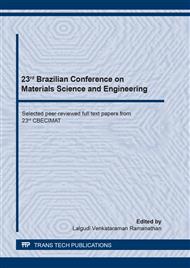p.3
p.9
p.14
p.20
p.26
p.32
p.37
p.43
Comparison of Mechanical Properties of Banana Fibers Reinforcement in Different Thermoset Matrix Composites
Abstract:
Banana fibers are among the natural lignocellulosic fibers with greater potential for use as reinforcement in polymer matrix composites. Attractive mechanical and physical properties as well as low cost of production are considered as the main advantages on the use of such fibers. This works aims to study the mechanical behavior of the banana fiber when used as filler to the two most commonly used thermoset matrices (epoxy and polyester). The specimens were produced with up to 30 vol% of banana fibers for both polymeric matrices. Tensile strength tests as well as macroscopic and microscopic evaluation of the fractured surface were carried out. It was shown that, indeed, the banana fiber provided a substantial reinforcement for both matrices. On the other hand, mechanical strength associated with the composite epoxy/banana was more than 50% higher than the exhibit by the polyester/banana one. Such behavior could be associated with the interfacial strength regarding the fiber and the matrix.
Info:
Periodical:
Pages:
20-25
Citation:
Online since:
October 2020
Price:
Сopyright:
© 2020 Trans Tech Publications Ltd. All Rights Reserved
Share:
Citation:


